Abstract
Cells of Staphylococcus aureus MF-31 which have been heat-injured at 52 C have an altered metabolic activity. Analyses of whole-cell preparations by means of the Thunberg technique and Warburg manometry showed decreased dehydrogenase activity and oxygen uptake on a variety of substrates. In cell-free extracts prepared from injured cells, it was demonstrated that the specific activity of fructose diphosphate aldolase, lactate dehydrogenase, and butanediol dehydrogenase was less than that of extracts prepared from normal unheated cells. Recovery of the heat-injured cells in a suitable medium supported a return of the dehydrogenase activity and oxygen uptake, but the activity of the enzymes in cell-free extracts prepared from such partially recovered cells did not fully return to the level of normal (unheated) preparations. Addition of chloramphenicol or actinomycin D to the recovery medium, singly or in combination, retarded the return of the normal metabolic activity. Radiorespirometric experiments indicated that the percentage participation of the Embden-Meyerhoff Parnas and hexose monophosphate pathways remained the same for normal and heat-injured cells. The sublethal heat treatment decreased the catabolic capabilities of S. aureus and the production of selected end products associated with the metabolism of glucose.
Full text
PDF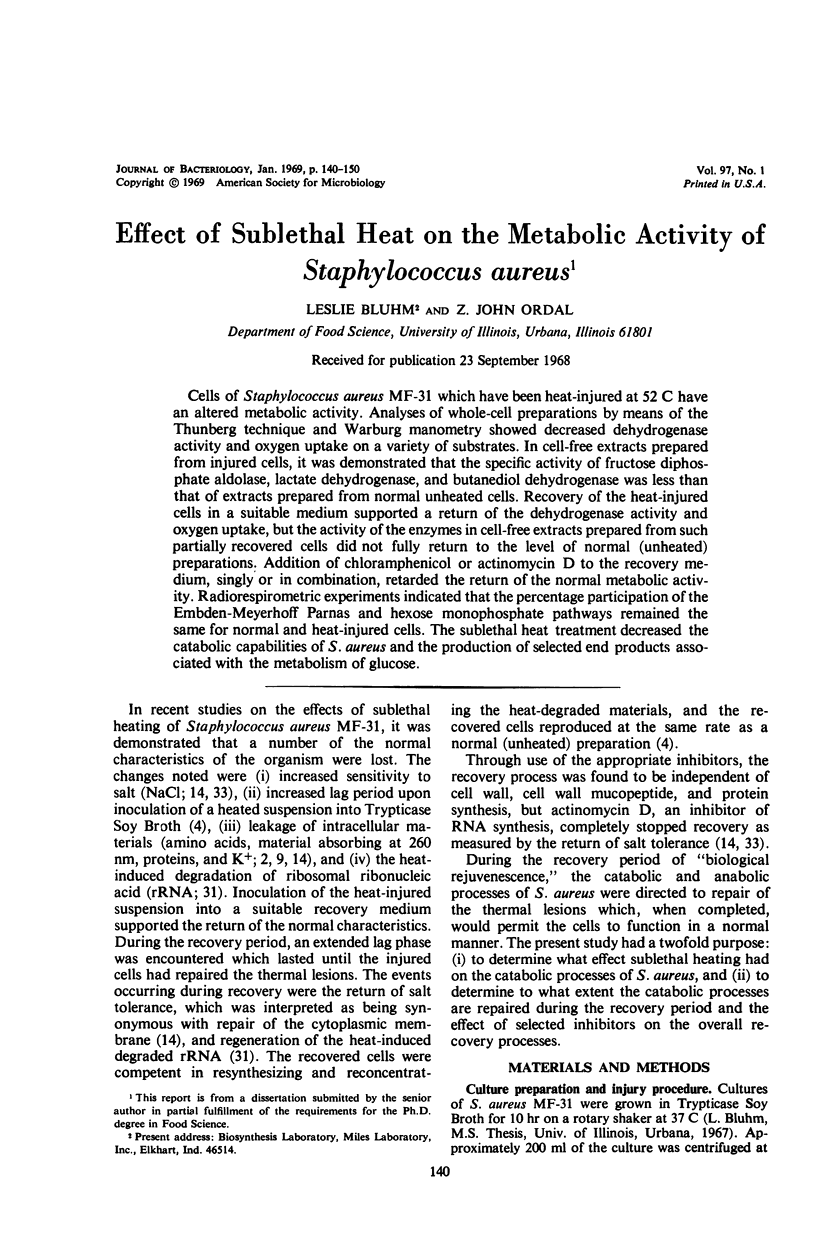
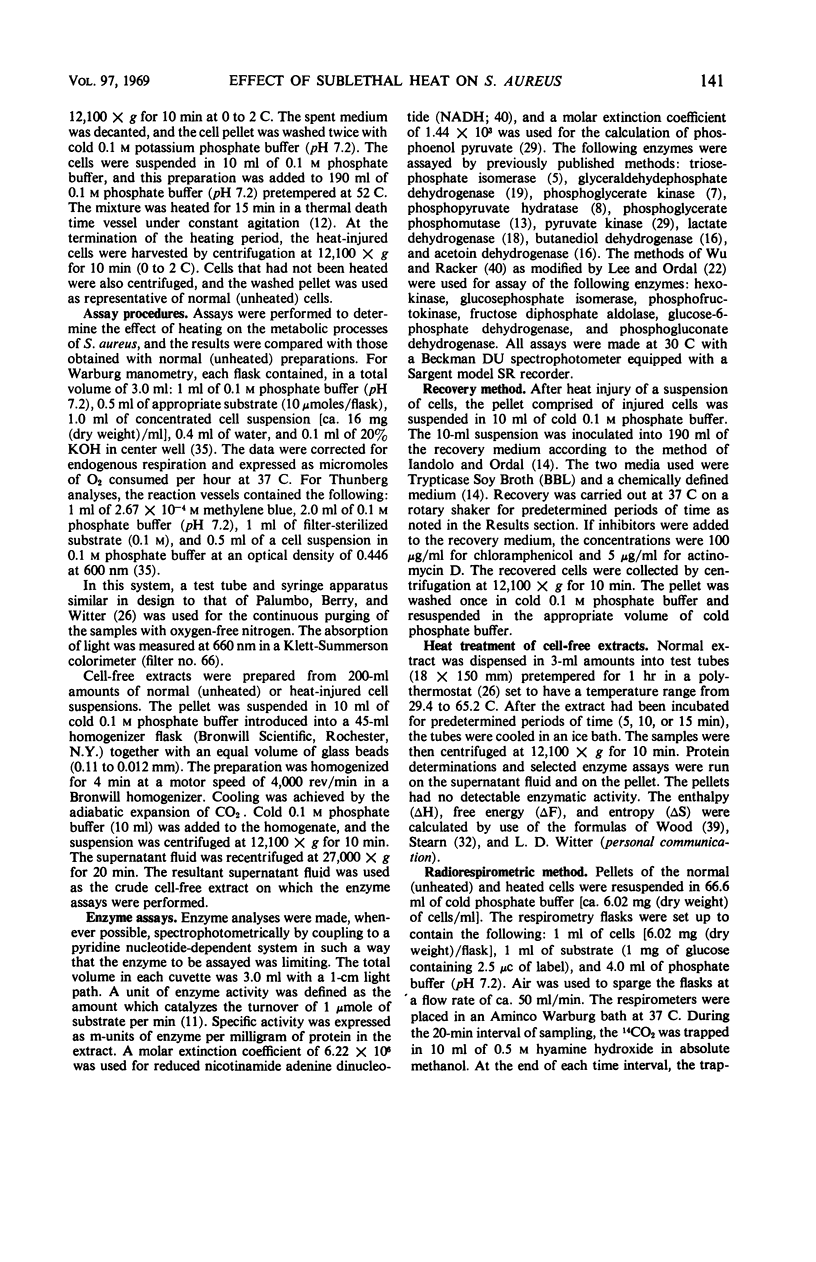
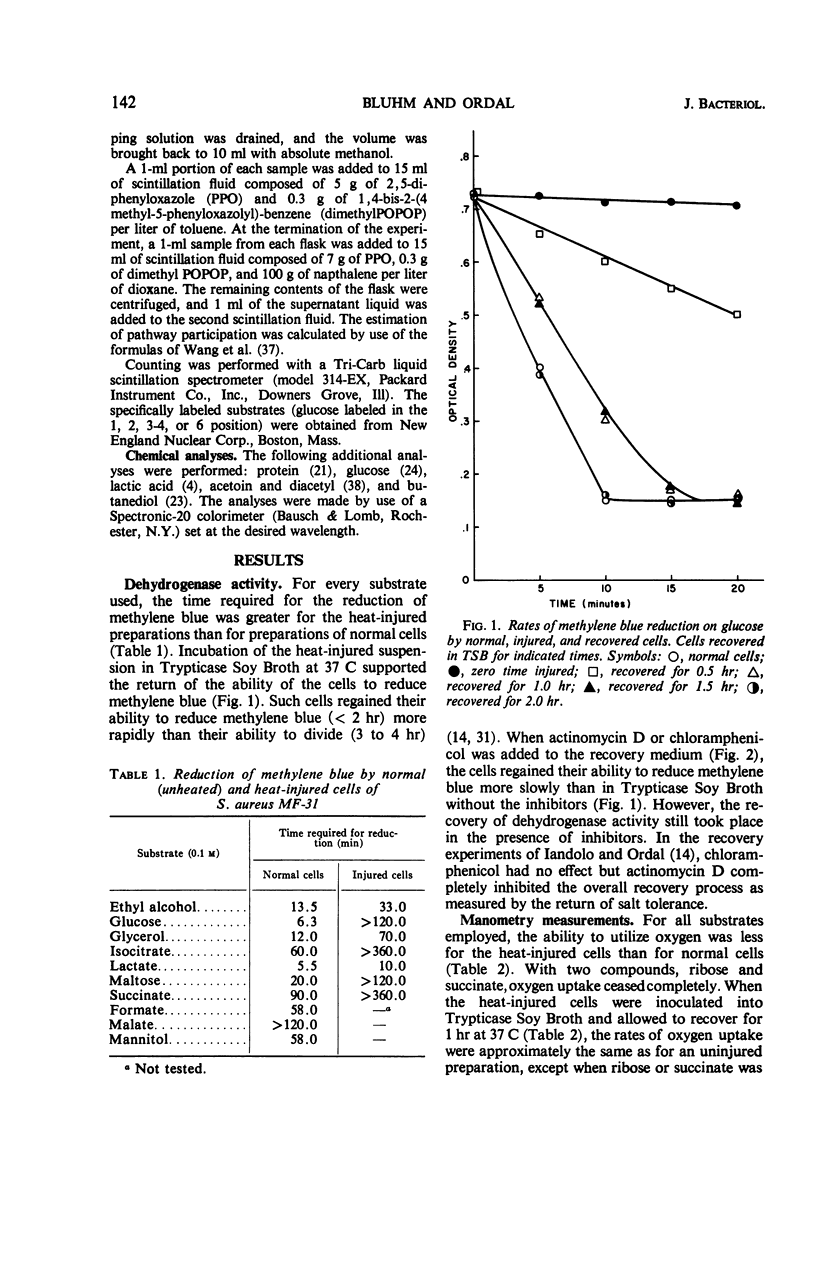
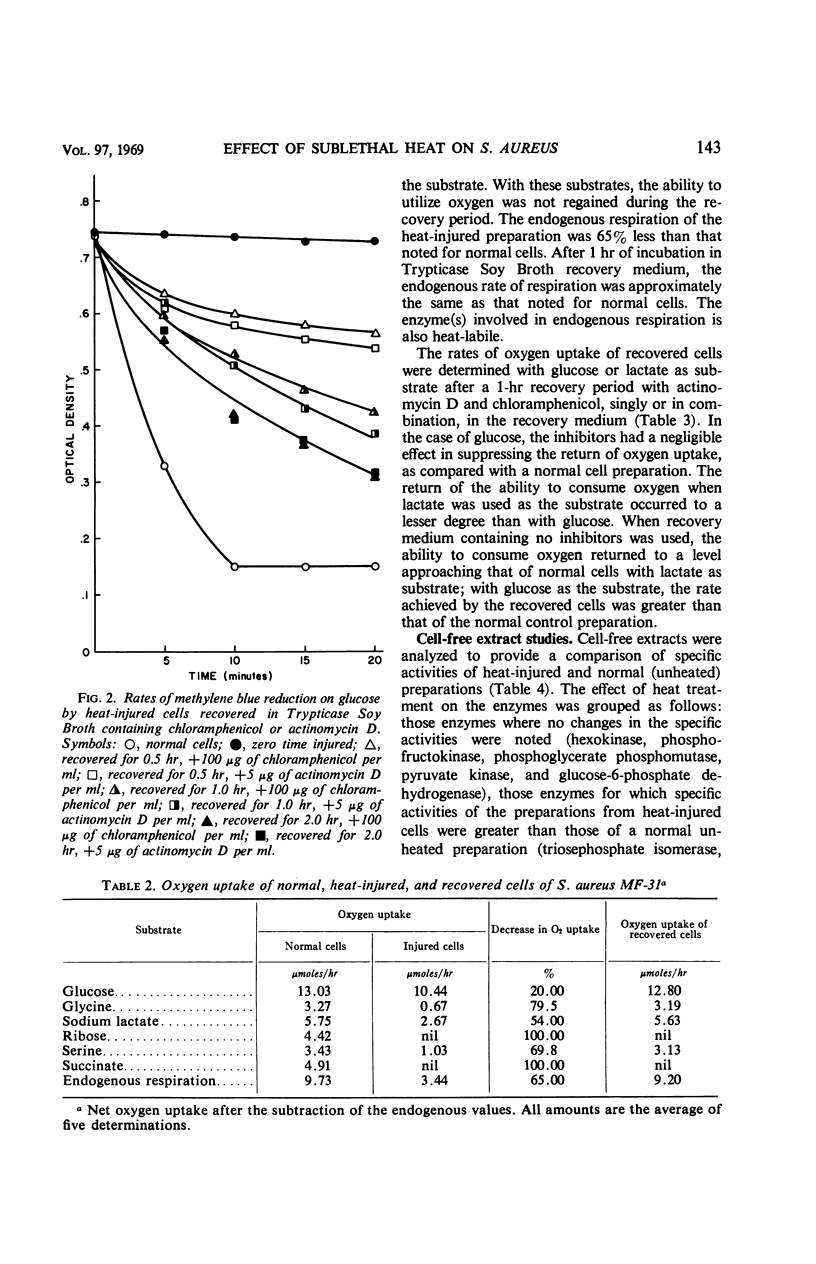
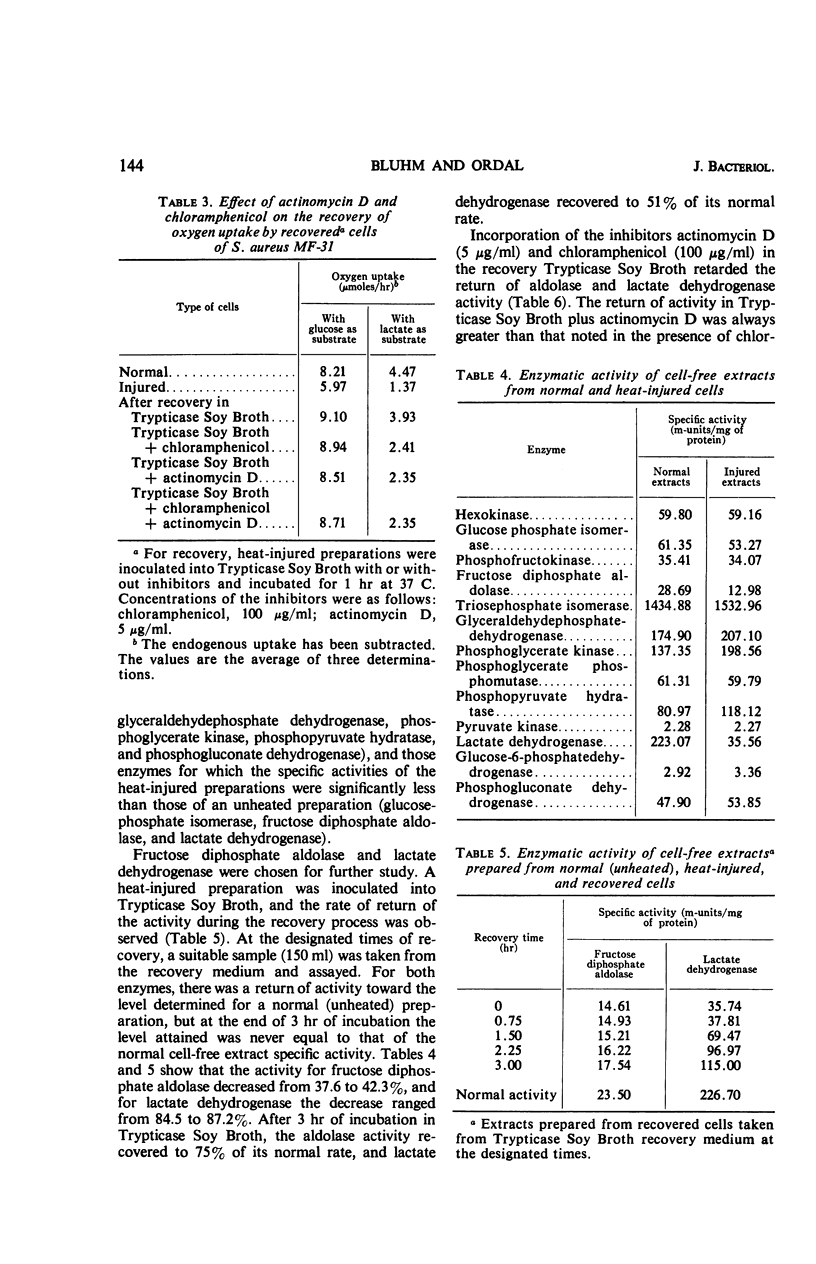
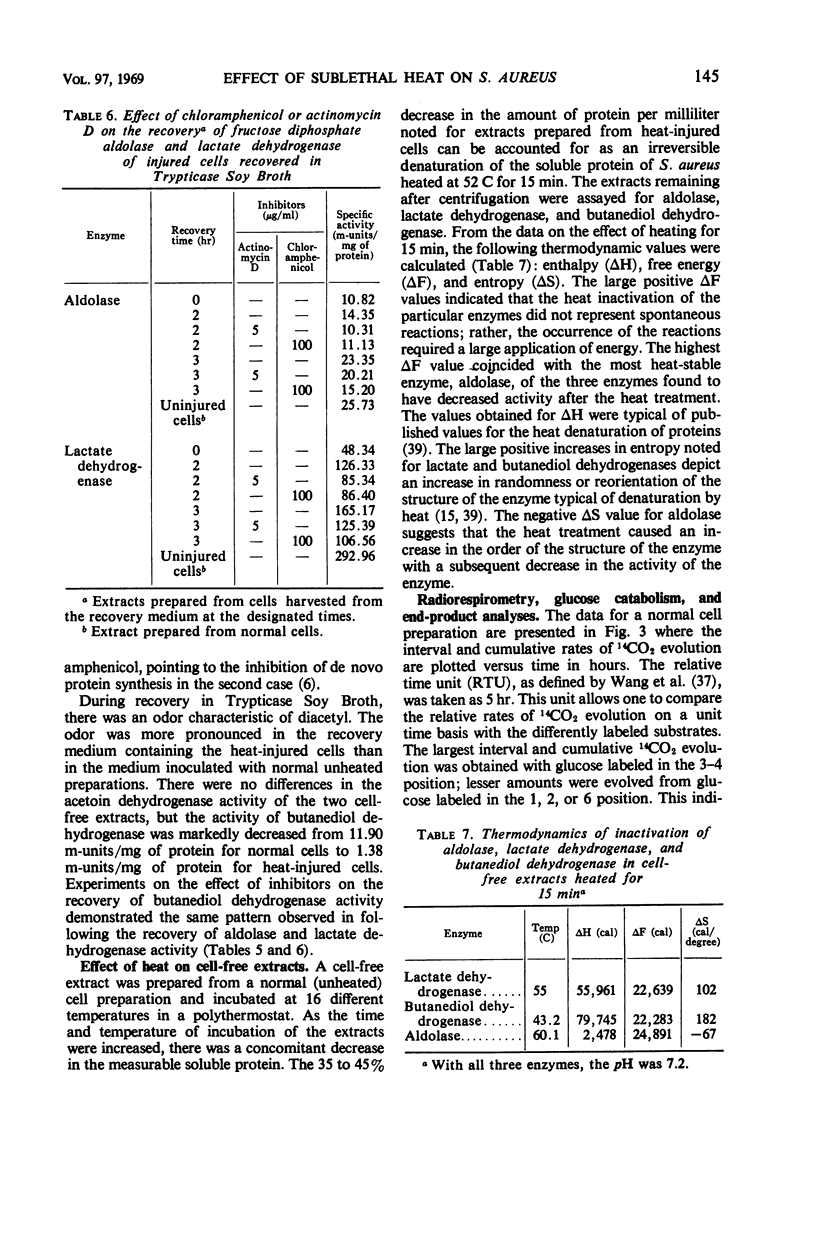
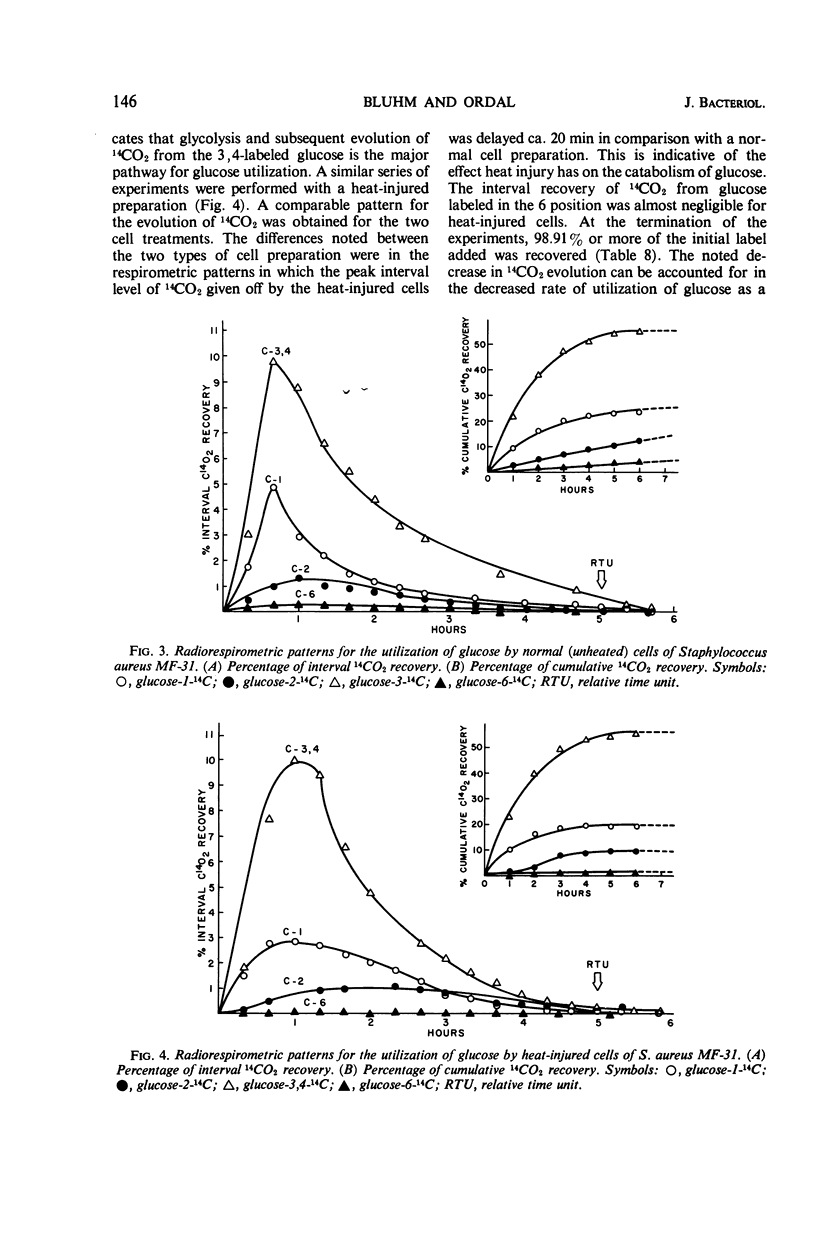
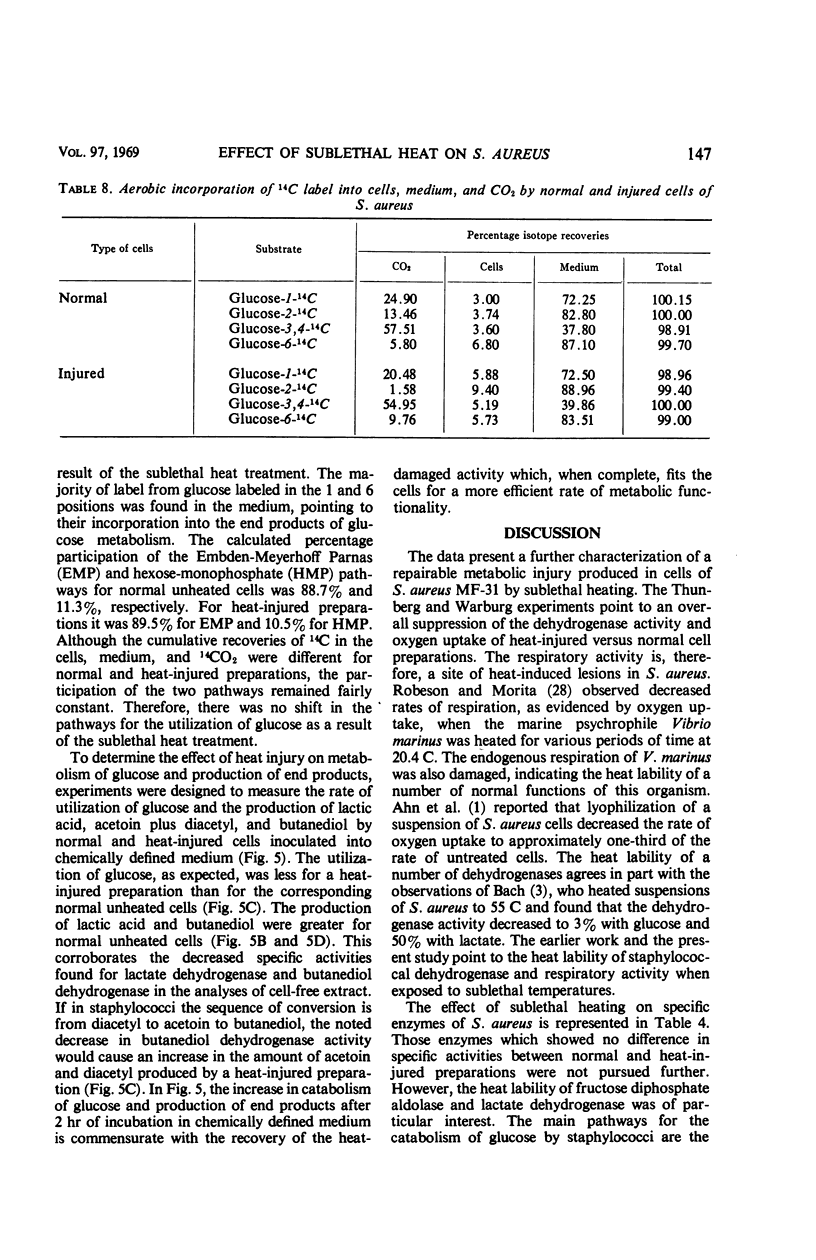
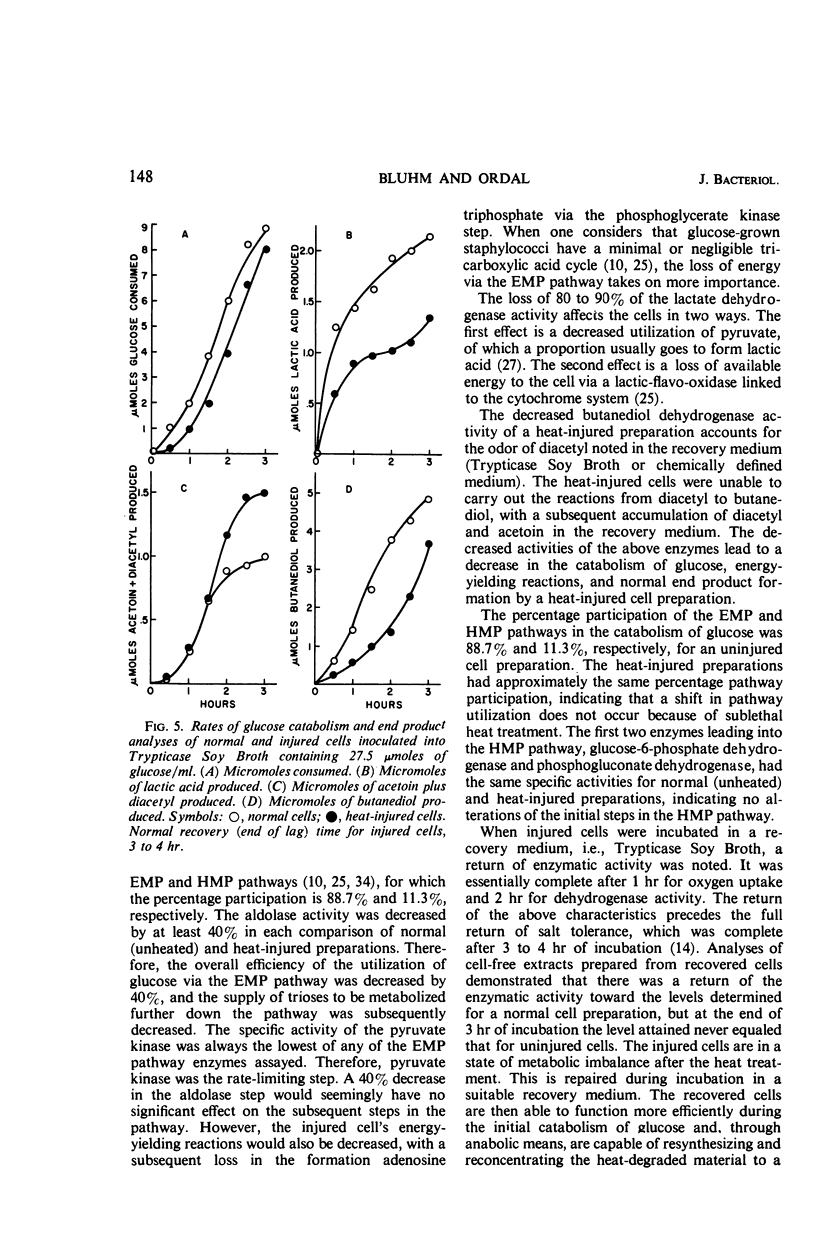
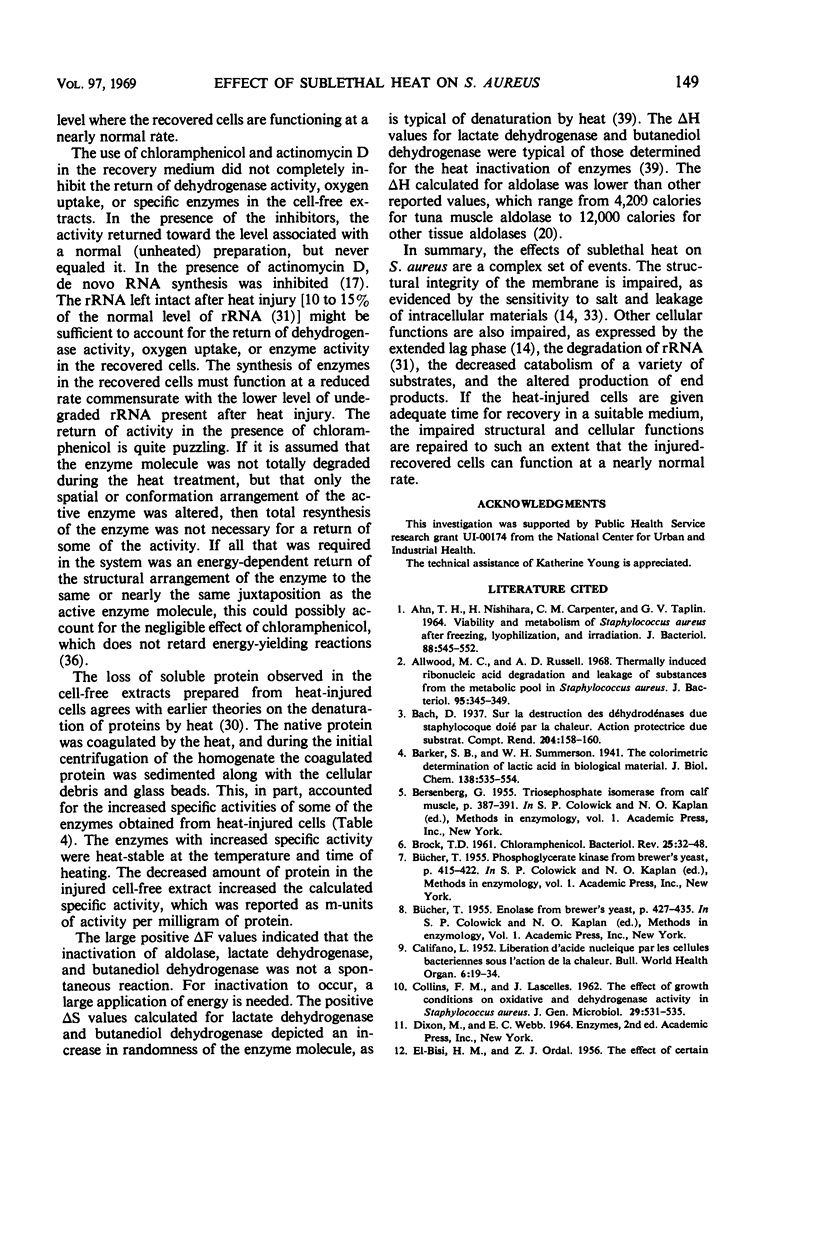
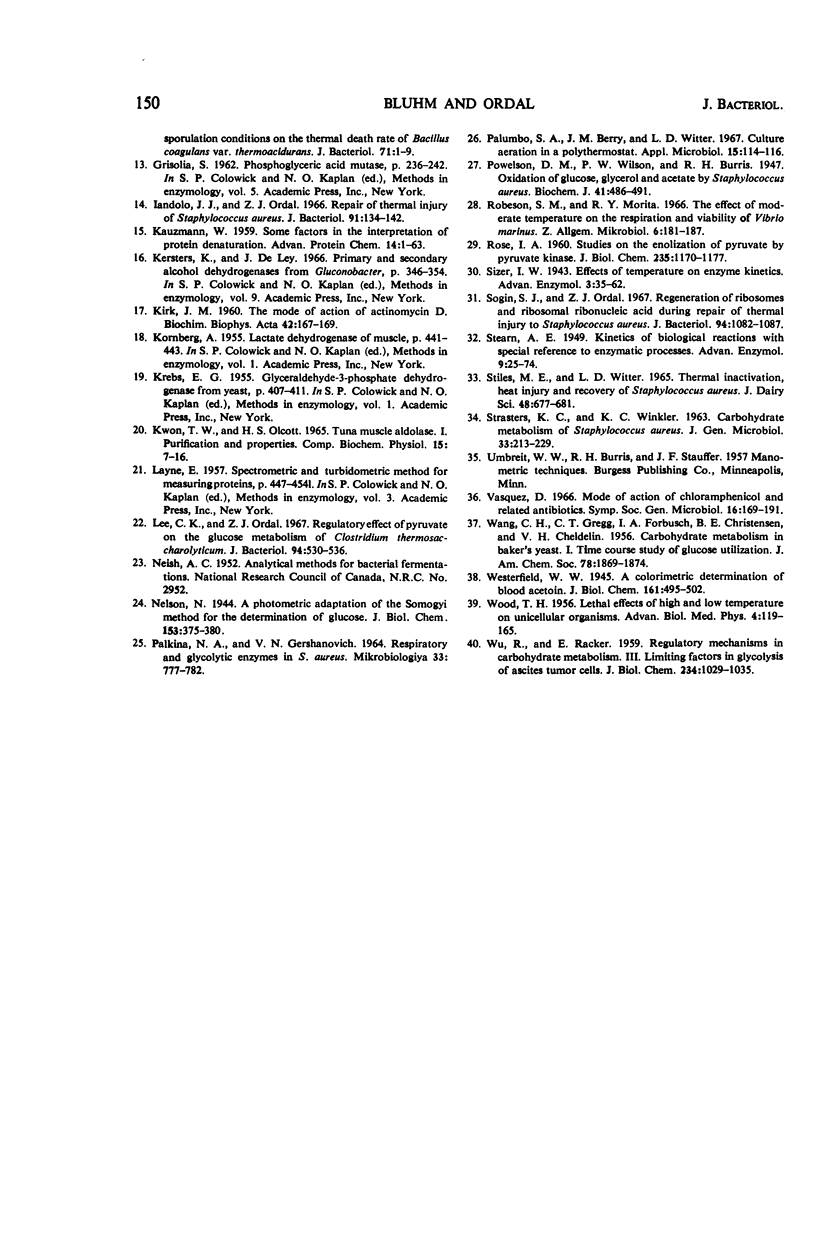
Selected References
These references are in PubMed. This may not be the complete list of references from this article.
- AHN T. H., NISHIHARA H., CARPENTER C. M., TAPLIN G. V. VIABILITY AND METABOLISM OF STAPHYLOCOCCUS AUREUS AFTER FREEZING, LYOPHILIZATION, AND IRRADIATION. J Bacteriol. 1964 Sep;88:545–552. doi: 10.1128/jb.88.3.545-552.1964. [DOI] [PMC free article] [PubMed] [Google Scholar]
- Allwood M. C., Russell A. D. Thermally induced ribonucleic acid degradation and leakage of substances from the metabolic pool in Staphylococcus aureus. J Bacteriol. 1968 Feb;95(2):345–349. doi: 10.1128/jb.95.2.345-349.1968. [DOI] [PMC free article] [PubMed] [Google Scholar]
- Brock T. D. CHLORAMPHENICOL. Bacteriol Rev. 1961 Mar;25(1):32–48. doi: 10.1128/br.25.1.32-48.1961. [DOI] [PMC free article] [PubMed] [Google Scholar]
- CALIFANO L. Libération d'acide nucléique par les cellules bactériennes sous l'action de la chaleur. Bull World Health Organ. 1952;6(1-2):19–34. [PMC free article] [PubMed] [Google Scholar]
- COLLINS F. M., LASCELLES J. The effect of growth conditions on oxidative and dehydrogenase activity in Staphylococcus aureus. J Gen Microbiol. 1962 Nov;29:531–535. doi: 10.1099/00221287-29-3-531. [DOI] [PubMed] [Google Scholar]
- Iandolo J. J., Ordal Z. J. Repair of thermal injury of Staphylococcus aureus. J Bacteriol. 1966 Jan;91(1):134–142. doi: 10.1128/jb.91.1.134-142.1966. [DOI] [PMC free article] [PubMed] [Google Scholar]
- KAUZMANN W. Some factors in the interpretation of protein denaturation. Adv Protein Chem. 1959;14:1–63. doi: 10.1016/s0065-3233(08)60608-7. [DOI] [PubMed] [Google Scholar]
- KIRK J. M. The mode of action of actinomycin D. Biochim Biophys Acta. 1960 Jul 29;42:167–169. doi: 10.1016/0006-3002(60)90769-1. [DOI] [PubMed] [Google Scholar]
- KWON T. W., OLCOTT H. S. TUNA MUSCLE ALDOLASE. I. PURIFICATION AND PROPERTIES. Comp Biochem Physiol. 1965 May;15:7–16. doi: 10.1016/0010-406x(65)90236-7. [DOI] [PubMed] [Google Scholar]
- Lee C. K., Ordal Z. J. Regulatory effect of pyruvate on the glucose metabolism of Clostridium thermosaccharolyticum. J Bacteriol. 1967 Sep;94(3):530–536. doi: 10.1128/jb.94.3.530-536.1967. [DOI] [PMC free article] [PubMed] [Google Scholar]
- PALKINA N. A., GERSHALOVICH V. N. FERMENTY DYKHANIIA I GLIKOLIZA STAPHYLOCOCCUS AUREUS. Mikrobiologiia. 1964 Sep-Oct;33:777–782. [PubMed] [Google Scholar]
- Palumbo S. A., Berry J. M., Witter L. D. Culture aeration in a polythermostat. Appl Microbiol. 1967 Jan;15(1):114–116. doi: 10.1128/am.15.1.114-116.1967. [DOI] [PMC free article] [PubMed] [Google Scholar]
- Powelson D. M., Wilson P. W., Burris R. H. Oxidation of glucose, glycerol and acetate by Staphylococcus aureus. Biochem J. 1947;41(4):486–491. doi: 10.1042/bj0410486. [DOI] [PMC free article] [PubMed] [Google Scholar]
- ROSE I. A. Studies on the enolization of pyruvate by pyruvate kinase. J Biol Chem. 1960 Apr;235:1170–1177. [PubMed] [Google Scholar]
- STILES M. E., WITTER L. D. THERMAL INACTIVATION, HEAT INJURY, AND RECOVERY OF STAPHYLOCOCCUS AUREUS. J Dairy Sci. 1965 Jun;48:677–681. doi: 10.3168/jds.s0022-0302(65)88321-7. [DOI] [PubMed] [Google Scholar]
- STRASTERS K. C., WINKLER K. C. CARBOHYDRATE METABOLISM OF STAPHYLOCOCCUS AUREUS. J Gen Microbiol. 1963 Nov;33:213–229. doi: 10.1099/00221287-33-2-213. [DOI] [PubMed] [Google Scholar]
- Sogin S. J., Ordal Z. J. Regeneration of ribosomes and ribosomal ribonucleic acid during repair of thermal injury to Staphylococcus. J Bacteriol. 1967 Oct;94(4):1082–1087. doi: 10.1128/jb.94.4.1082-1087.1967. [DOI] [PMC free article] [PubMed] [Google Scholar]
- WOOD T. H. Lethal effects of high and low temperatures on unicellular organisms. Adv Biol Med Phys. 1956;4:119–165. doi: 10.1016/b978-1-4832-3110-5.50008-x. [DOI] [PubMed] [Google Scholar]
- WU R., RACKER E. Regulatory mechanisms in carbohydrate metabolism. III. Limiting factors in glycolysis of ascites tumor cells. J Biol Chem. 1959 May;234(5):1029–1035. [PubMed] [Google Scholar]


